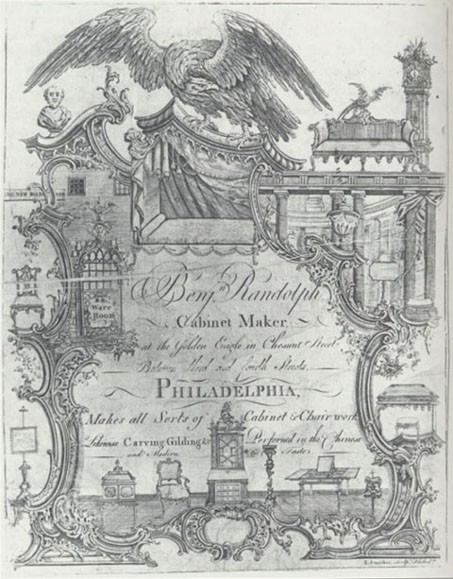
James Smither, Benjamin Randolph trade card, Philadelphia, 1769. Line engraving on paper. 9" x 7". (Courtesy, The Library Company of Philadelphia.)
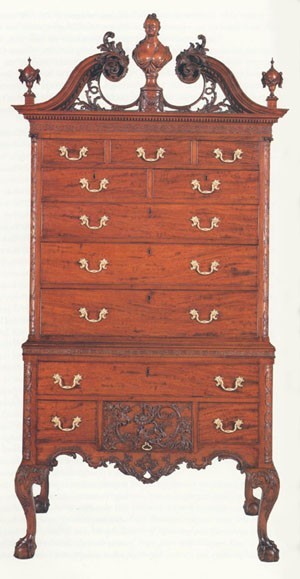
High chest, Philadelphia, 1762–1775. Mahogany with tulip poplar, white cedar, and yellow pine. H. 91 3/4", W. 44 5/8", D. 24 5/8". (The Metropolitan Museum of Art, Kennedy Fund. (1918, acc. 18.110.4) Photograph, all rights reserved, The Metropolitan Museum of Art.)

Design for a desk-and-bookcase illustrated on pl. 108 in the third edition of Thomas Chippendale’s Gentleman and Cabinet-Maker’s Director (London, 1762). (The Metropolitan Museum of Art, The Elisha Whittelsey Colllection, The Elisha Whittelsey Fund, 1982. (acc. 1982.1133, pl. 108) Photograph, all rights reserved, The Metropolitan Museum of Art.)
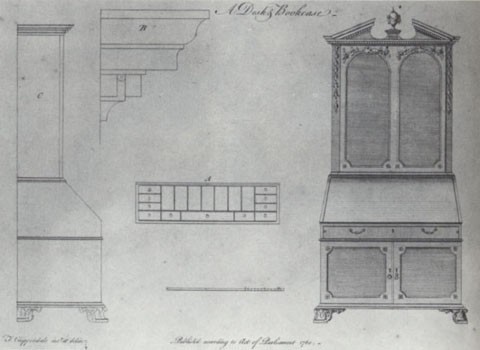
Design for a desk-and-bookcase illustrated on pl. 107 in the third edition of Thomas Chippendale’s Gentleman and Cabinet-Maker's Director (London 1762). (The Metropolitan Museum of Art, The Elisha Whittelsey Collection, The Elisha Whittelsey Fund, 1982. (acc. 1982.1133, pl. 107) Photograph, all rights reserved, The Metropolitan Museum of Art.)
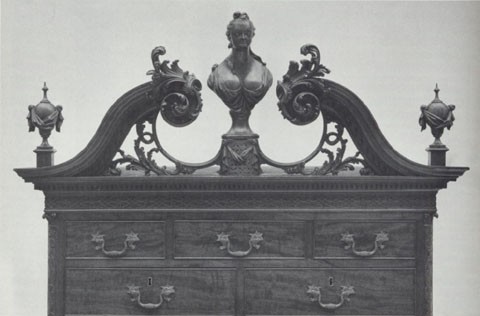
Detail of the cornice of the high chest illustrated in fig. 2. In both size and profile, the cornice exactly matches the full-scale cornice detail illustrated in fig. 4. (Photograph, all rights reserved, The Metropolitan Museum of Art.)
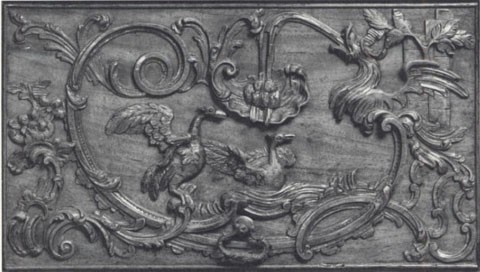
Detail of the bottom drawer appliqué of the high chest illustrated in fig. 2. (Photograph, all rights reserved, The Metropolitan Museum of Art.)

Design for a chimneypiece tablet on pl. 5 in Thomas Johnson’s New Book of Ornaments (London, 1762). (The Metropolitan Museum of Art, Gift of Harvey Smith, 1985. (acc. 1985.1099 pl. 5) Photograph, all rights reserved, The Metropolitan Museum of Art.)
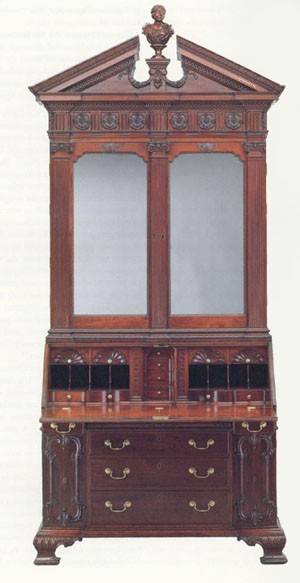
Desk-and-bookcase, Philadelphia, ca. 1765. Mahogany with yellow pine, white cedar, tulip poplar, and white oak. (Collection of George and Linda Kaufman; photo, Dirk Bakker.)
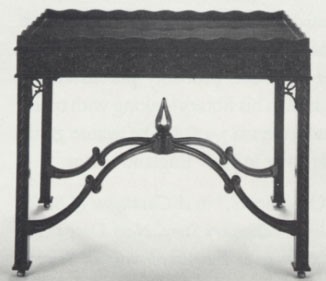
China table attributed to Robert Harrold, Portsmouth, 1765–1775. Mahogany and mahogany veneer with maple and white pine. H. 28 5/8", W. 36 1/4", D. 22 7/8". (Courtesy, Carnegie Museum of Art, museum purchase: Richard King Mellon Foundation grant, acc. 72.55.2.)
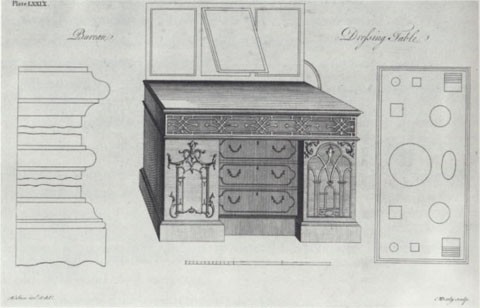
Design for bureau dressing table illustrated on pl. 40 of William Ince and John Mayhew’s Universal System of Houshold Furniture (1762). (The Metropolitan Museum of Art, Harris Brisbane Dick Fund, 1934. (acc. 34.100 pl 40) Photograph, all rights reserved, The Metropolitan Museum of Art.)

Wall bracket, Philadelphia, 1765–1775. White pine. H. 16 1/4", W. 12 7/8", D. 5 1/2". (Courtesy, Winterthur Museum, acc. 58.2242.)
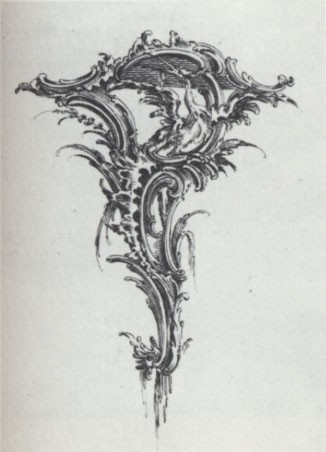
Design for a wall bracket illustrated on pl. 42 of Thomas Johnson’s One Hundred and Fifty New Designs (1761) engraving on paper. (The Metropolitan Museum of Art, Harris Brisbane Dick Fund, 1932. (acc. 32.61 pl 42) Photograph, all rights reserved, The Metropolitan Museum of Art.)
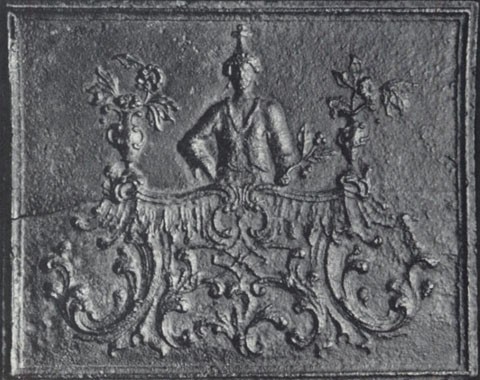
Side plate from a six-plate stove attributed to Marlboro Furnace, Frederick County, Virginia, 1768–1780. H. 21 7/8", W. 27 1/2". (Colonial Williamsburg Foundation, partial gift of Liza and Wallace Gusler, acc. 1992–123.)

Design for a chimneypiece illustrated on pl. 7 of Matthias Lock and Henry Copland’s New Book of Ornaments (1752-1768). (The Metropolitan Museum of Art, Harris Brisbane Dick Fund, 1928 (acc. 28.88.7) Photograph, all rights reserved, The Metropolitan Museum of Art.)

Side chair, Boston, 1765–1785. Mahogany with maple. H 38 3/4", W. 23 5/8", D. 21". (The Metropolitan Museum of Art, Gift of Mrs. Paul Moore, 1939. (acc. 39.88.1) Photograph, all rights reserved, The Metropolitan Museum of Art.)
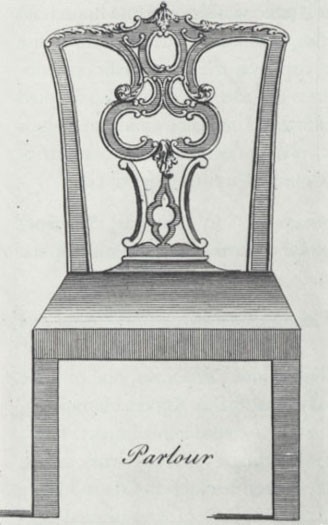
Design for a “Parlour” chair illustrated on pl. 9 of Robert Manwaring’s Cabinet and Chair-Maker’s Real Friend and Companion (1765). (The Metropolitan Museum of Art, Harris Brisbane Dick Fund (acc. 32.9.6.) Photograph, all rights reserved,The Metropolitan Museum of Art.)
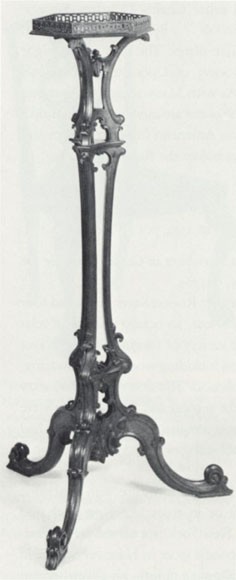
Candlestand attributed to the Anthony Hay shop, Williamsburg, Virginia, 1774–1776. Mahogany. H. 48", W. (top) 10". (Courtesy, Mount Vernon Ladies Association.)
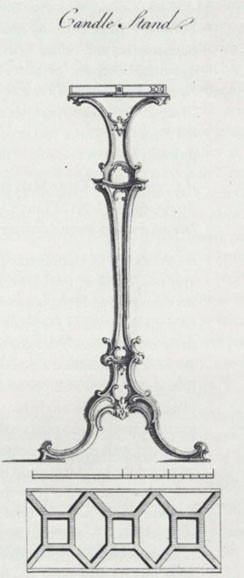
Design for a candlestand illustrated on pl. 1 of the Society of Upholsterers’ Household Furniture in Genteel Taste (1760). (The Metropolitan Museum of Art, Harris Brisbane Dick Fund, 1929. (acc. 29.43, pl.1) Photograph, all rights reserved, The Metropolitan Museum of Art.)

Side chair, Salem, Massachusetts, 1790–1800, attributed to Samuel McIntire. Mahogany, ebony, ash, birch, white pine, H. 37 7/8", W. 27 7/8", D. 18". (The Metropolitan Museum of Art, The Friends of the American Wing Fund, 1962 (acc. 62.16) Photograph, all rights reserved, The Metropolitan Museum of Art.)

Design for a side chair illustrated on pl. 2 of George Hepplewhite’s Cabinet-Maker and Upholsterer’s Guide (1788). (The Metropolitan Museum of Art, Rogers Fund, 1952, acc. 52.519.187) All rights reserved, The Metropolitan Museum of Art.

Arm chair, Salem, Massachusetts, 1790–1800, attributed to Samuel McIntire. Mahogany with birch and white pine. H. 32 1/2", W. 21", D. 18". (The Metropolitan Museum of Art, Rogers Fund, 1945 (acc.45.105) Photograph, all rights reserved, The Metropolitan Museum of Art.)
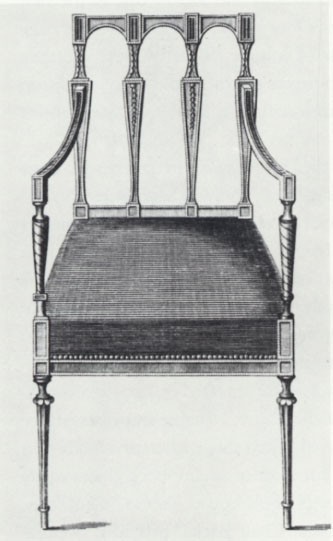
Design for a side chair illustrated in pl. 33 of Thomas Sheraton’s Cabinet-Maker & Upholsterer’s Drawing Book (1793). (The Metropolitan Museum of Art, Rogers Fund, 1952, acc.52.519.25.. pl.33.) All rights reserved, The Metropolitan Museum of Art.

James Akin, Joseph B. Barry trade card, Philadelphia, ca. 1810. Line engraving on paper. From an advertisement by the Old Print Shop, in Antiques 34, no. 1 (July, 1938): 36.
The eighteenth century in England was the golden age of books illustrating architecture and furniture designs. The approximately 250 different architectural titles and 40 furniture titles published were a principal means for the transmission of London designs throughout the English-speaking world, and they deserve much of the credit for the pleasing proportions and quality construction that characterize Georgian architecture and furniture, be it from London, Dublin, or Philadelphia.[1]
Early historians of American furniture, such as Irving W. Lyon and Luke Vincent Lockwood, acknowledged the influence of British pattern books, but the first serious student of published design sources for American furniture was Fiske Kimball. During the 1920s he incorporated the results of his research in articles on American architecture, Philadelphia furniture, and Thomas Chippendale. Over the ensuing years scholars assembled a sizeable body of information documenting the existence of these books in America. Helen Park’s well-known List of Architectural Books Available in America before the Revolution itemizes more than 100 different architectural titles. This article provides a similar compilation of furniture design books.[2]
All told, we now have nearly seventy individual references to nineteen different furniture books, and a twentieth title is included in the checklist because Philadelphia artisans clearly utilized engravings from it. Most of the references were culled from the catalogues of colonial booksellers and libraries, newspaper advertisements, and estate inventories of architects and cabinetmakers.[3] In three instances the actual volumes owned by American craftsmen have been identified by signatures in the books. Although additional references undoubtedly will come to light as eighteenth-century manuscript and printed documentary sources are studied systematically, now that we have a journal devoted to American furniture it seems fitting and timely to bring together all the known material.
Modern distinctions between books of architecture and of design are not always accurate since some architectural books, such as Batty and Thomas Langley’s The City and Country Builder’s and Workman’s Treasury of Designs (1740), contain patterns for furniture. In addition, some furniture design books, such as Thomas Chippendale’s Gentleman and Cabinet-Maker’s Director (1754), occasionally have engravings of chimneypieces and other interior details. The collections of ornamental designs by John Stalker and George Parker, P. Baretti, Henry Copland, Thomas Johnson, and Matthias Lock are included in this study because they were primarily for the decoration of furniture. However, catalogues illustrating brass furniture hardware made by Birmingham and Sheffield manufactories—a wide variety of drawer pulls, keyhole escutcheons, and casters—are excluded from the checklist because they were tangential to furniture design.[4]
Most of the furniture design books published in Britain during the eighteenth century were available in America. Notable among them were the major works in the rococo style by Chippendale, Johnson, William Ince and John Mayhew, Robert Manwaring, and the Society of Upholsterers. Absent are a number of books by late baroque (including Palladian) designers, such as Gaetano Brunetti’s Sixty Different Sorts of Ornaments (1736), William Jones’s Gentlemen or Builder's Companion (1739), or De La Cour’s various Books of Ornament (1741–1747). Likewise, there is no record of the Chinese designs of Matthew Darly, William Halfpenny, and Sir William Chambers, nor is there evidence of any of Lock’s suites of carver’s ornaments and furniture designs in America before the 1780s.[5]
All the books recorded in America are British; so too are the individual designs, excepting the French and German plates pirated by the Langleys for the Treasury (1740). The books ran the gamut from princely folio size to pocket handbook, but most were modest volumes intended to guide tradesmen in constructing fashionable furniture. Aside from Thomas Jefferson’s copy of Chippendale’s Gentleman and Cabinet-Maker’s Director (1755 edition), no other design book has a history of ownership by an American merchant, professionals, or other member of the colonial elite.[6]
Several London booksellers settled in American cities in the decades before the Revolution. More than half of the references uncovered are from their advertisements and catalogues. Chief among these men were James Rivington and Garret Noel, who arrived in New York in 1760 and 1762, respectively; the firm of Cox and Berry, which opened a shop in Boston in 1766; Robert Wells, who immigrated to Charleston about 1766; and Robert Bell, a Scot who dominated the book trade in Philadelphia from 1768 until his death in 1784. Their presence helps explain the overwhelmingly London orientation of titles found in America.[7]
These booksellers brought with them, or later imported, a variety of titles, particularly modest pattern books such as P. Baretti’s New Book of Ornaments for the Year 1766, John Crunden’s Joyner and Cabinet-Maker’s Darling (1765), Manwaring’s Cabinet and Chair-Maker’s Real Friend and Companion (1765), and the Society of Upholsterers’ Houshold Furniture in Genteel Taste (1760). Chippendale’s Director and Ince and Mayhew’s Universal System of Houshold Furniture (1762) were not offered in America until 1766, presumably because these elegant folios were too costly to import on speculation.
The books of baroque designs had little influence on colonial furniture styles. Langley’s Treasury, for example, was an important design source for American builders, but only two pieces of colonial furniture—altarpieces designed by Newport architect, Peter Harrison—derive from this book. Likewise, Stalker and Parker’s Treatise of Japanning and Varnishing (1688) and John Vardy’s Some Designs of Inigo Jones and William Kent (1744) appeared in America late in the eighteenth century and evidently had no influence whatsoever. The collections of rococo designs had a much greater impact. Manwaring’s Cabinet and Chair-Maker’s Real Friend and Companion determined the basic look, and occasionally the details, of much Boston seating furniture, whereas Chippendale’s Director had a broad influence on furniture styles in the Middle Atlantic region, particularly Philadelphia, and in the South. Somewhat later, volumes of neoclassical designs such as George Hepplewhite’s Cabinet-Maker and Upholsterer’s Guide (1788) and Thomas Sheraton’s Cabinetmaker & Upholsterer’s Drawing Book (1793) had a broad and immediate influence in introducing the “antique” taste.
American pieces directly influenced by pattern books are, however, very much the exception, for most colonial furniture conforms more to regional styles than to pattern book designs. It is primarily with costly commissioned furniture—be it rococo or neoclassical—that we find precise borrowings. The reason for this is that the fashion for the rococo—an ornamental style promulgated through design books—coincided with a period of growing tension between England and her colonies during the 1760s. Although the American merchant elite hungered for fashionable London goods, there was broad-based sentiment for boycotting British goods and encouraging home manufactures. There was thus a market for American-made goods in the latest London style. To fill that need, highly skilled cabinetmakers and carvers immigrated to the colonies, there to make furniture that proclaimed its owner’s familiarity with current London fashion. For example, Philadelphia cabinetmaker Benjamin Randolph paid for the passage of London-trained carvers Hercules Courtenay and John Pollard in 1765.[8]
Randolph’s trade card (fig. 1) graphically illustrates the importance of pattern books in the transmission of London rococo designs to the colonies. In 1769 Randolph commissioned James Smither to engrave the card as an advertisement for his new shop, the Golden Eagle. The furniture designs that surround the cartouche were copied from popular pattern books. The message they imparted to Randolph’s chosen market, those cosmopolitan Philadelphians who could afford to import furnishings from London but for political reasons deemed it expedient not to do so, was clear: “I can provide you with American-made furniture based upon designs that your peers will recognize as being in the latest London style.”
The high chest illustrated in figure 2 shows how cabinetmakers and carvers in the colonies mined design books for motifs. In London the high chest—a flat-top chest of drawers with six turned legs—was a purely baroque form that went out of fashion by 1710, but in the colonies it evolved into a prestigious and uniquely American creation. During the 1730s New England craftsmen gave the high chest a scroll top with a central drawer, a large central bottom drawer (often with a carved shell), and cabriole legs. The evolution of this form continued in Philadelphia during the 1750s, when the pediment drawer was superceded by broad carved appliqués, and during the mid- to late 1760s, when an extended cornice separated the pediment from the drawers in an architecturally correct manner. Figure 2 is a perfect example of the last, and judging from the tentative and laborious construction methods employed in fashioning the pediment, this object must be one of the first attempts at this design.
The cabinetmaker and carver responsible for this high chest (long-known as the “Pompadour”) copied details from two pattern books published in London in 1762. The pediment, with scroll volutes metamorphosing into acanthus leaves, the cornice and draped urn finials, and the basic idea of the bust ornament come from two desk-and-bookcases illustrated in the third edition of the Director (figs. 3-5). The drawer appliqué, however, is copied from a design for a chimneypiece tablet in Thomas Johnson’s New Book of Ornaments (figs. 6, 7). These pattern book details clearly attest to a familiarity with modish London style, yet, as a whole, the high chest is an original American statement.
In the following checklist and catalogue, all of the furniture pattern books documented in America before 1800 are arranged, first by the style of their designs, then alphabetically by author. (The checklist gives only the dates of editions found in America; the catalogue gives the dates of all eighteenth-century editions.) The catalogue entries are numbered sequentially, and each begins with a bibliographical synopsis of the book and commentary about its availability and influence. Within each entry, individual references are listed chronologically. Where possible, all catalogue references have been checked against the original sources and page numbers given. The citations at the end of each reference are abbreviations for the publications listed under “References Consulted” at the end of the catalogue section.
Checklist of English Furniture Pattern Books in Eighteenth-Century America
BAROQUE
1. Langley, Batty and Thomas. The City and Country Builder’s and Workman’s Treasury of Designs, 1745, 1750, 1756.
2. Stalker, John, and George Parker. A Treatise of Japanning and Varnishing, 1688.
3. Vardy, John. Some Designs of Inigo Jones and William Kent, 1744
ROCOCO
4. Baretti, P. A New Book of Ornaments, 1762 and/or 1766.
5. Chippendale, Thomas. The Gentleman and Cabinet-Maker’s Director, 1754, 1755, 1762.
6. Copland, Henry. A New Book of Ornaments, 1746.
7. Crunden, John. The Joyner and Cabinet-Maker’s Darling, 1765.
8. Ince, William, and John Mayhew. The Universal System of Houshold Furniture, 1762.
9. Johnson, Thomas. One Hundred and Fifty New Designs, 1758, 1761.
10. Johnson, Thomas. A New Book of Ornaments, 1762.
11. Lock, Matthias. A New Book of Ornaments for Looking Glass Frames . . . &c., ca. 1752 or ca. 1768.
12. Lock, Matthias. A Book of Tables . . . &c., 1768.
13. Lock, Matthias, and Henry Copland. A New Book of Ornaments, 1752 or 1768.
14. Manwaring, Robert. The Cabinet and Chair-Maker’s Real Friend and Companion, 1765.
15. Manwaring, Robert. The Chair-Maker’s Guide, 1766.
16. Society of Upholsterers. Houshold Furniture in Genteel Taste, 1760
NEOCLASSICAL
17. Adam, Robert and James. The Works in Architecture, 1773–1778, 1779.
18. Hepplewhite, George. The Cabinet-Maker and Upholsterer’s Guide, 1788, 1789, or 1794.
19. London Society of Cabinet Makers. The Cabinet-Makers’ London Book of Prices, 1788 or 1793.
20. Sheraton, Thomas. The Cabinet-Maker & Upholsterer’s Drawing Book, 1793
Catalogue of English Furniture Pattern Books in Eighteenth-Century America
BAROQUE
1. Batty and Thomas Langley, The City and Country Builder’s and Workman’s Treasury of Designs, London, 1740, 1745, 1750, 1756, 1770.
The Treasury of Designs was one of the most popular of the various architectural pattern books cobbled together by Batty Langley, an architect and drawing master, and his brother Thomas, an engraver. Its furniture designs are mostly copied from engravings of continental designers. There are two bracket clocks (after J. F. Lauch), six marble tables (after Nicolas Pineau), three table frames, one medal case, one chest on stand, one dressing table (after J. J. Schubler), eight bookcases, and six altarpieces. All plates but one are signed “Thomas Langley invent and sculp,” and most are dated 1739. The exception, a design for a chest of drawers, is signed “Batty Langley Invent and Delin.”[9]
Booksellers advertised the Treasury in Philadelphia, New York, and Boston. Artisans who owned a copy included Philadelphia carpenters Robert Smith and John King, Virginia and Maryland architect William Buckland, and Boston builder Thomas Dawes. Newport architect Peter Harrison based his designs for the altar in King’s Chapel in Boston (1749) and the Ark in Touro Synagogue in Newport (1759) on plate 108, but there is no reference to the book in the catalogue of his library.[10] Most of the heavy baroque pier tables and bookcases illustrated in this volume were inappropriate for the scale and style of colonial life, and, with the exception of Harrison’s alterpieces, the Treasury had no influence on American furniture designs.
1.1. 1751. “Robert Smith, his book, Philada 1751,” inscribed in copy of the 1750 ed., Carpenters Company Library, Philadelphia (Hummel, 1955, p. 30).
1.2. 1755. “Langley’s builder’s designs,” in advertisement, “Imported in the last vessels from London, and to be sold by David Hall, At the New-Printing-Office, in Market-street, Philadelphia, the following Books, viz,” in Pennsylvania Gazette, January 21, 1755, p. 2 (Hummel, 1955, pp. 30–31).
1.3. After 1756. “John King” inscribed in copy of the 1756 ed., Carpenter’s Company Library, Philadelphia (Hummel, 1955, p. 30).
1.4. 1760. “Langley’s builder’s and workman’s treasury of designs,” in broadside, “Books Imported in the last Vessel from London, and to be sold by David Hall, at the New-Printing-Office, in Market-street, Philadelphia,” 1760 (Evans, 8362; Hummel, 1955, p. 31).
1.5. 1760. “Langley’s Builder’s Treasury, Designs for Builders and other Artists,” in A Catalogue of Books, lately Imported, and Sold by James Rivington Bookseller and Stationer from London, at his store over against the Golden Key, in Hanover-Square, New-York. And also at His Store next Door to Messrs. Taylor and Cox, in Front Street, Philadelphia, New York, 1760 (Winans, 41; Hummel, 1955, pp. 30–31).
1.6. 1760. “Langley’s City and Country Builders andWorkman’s Treasury of Designs, 4to,” in advertisement, “The following new Books, &c To Be Sold, Enquire of the Printer,” in Boston News-Letter, March 13, 1760 (Dow, p. 221; Park, 42).
1.7. ca. 1760. “Langley’s City and Country Builders and Workmans Treasury of Designs,” in A Catalogue of Books, Just Imported from London, And to be Sold by W. Bradford, At the London-Coffee-House, Philadelphia, ca. 1760, p. 9 (Evans, 8555; Winans, 34; Hummel, 1955, p. 31).
1.8. 1761. “Langley’s Treasury of Designs, 4to,” in advertisement, “Lately Imported, and to be Sold the following Books, &c. Among which are a Variety upon Architecture, Enquire of the Printers,” in Boston Gazette and Country Journal, November 30, 1761, p. 2 (Dow, p. 222).
1.9. 1762. “Langley’s Builder’s and Workman’s Treasury of Designs, 4to,” in advertisement of books offered for sale “At Mr. Holbrook’s House in the Common, Boston,” in Boston News-letter, February 18, 1762 (Dow, p. 222).
1.10. 1762. “Langley’s Builder’s Treasury, designs for Builders and other Artists,” in A Catalogue of Books, sold by Rivington and Brown, Booksellers and Stationers from London, At their Stores, over against the Golden Key, in Hanover-Square, New-York: and Over against the London Coffee-House, in Philadelphia. At both which Places will be found, a constant Supply of Books, with all the new Articles as they are published in Europe; and from whence all Orders directed to them from the Country, whether in a wholesale or retail Way, will be punctually complied with, Philadelphia (?), 1762, p. 66, no. 750 (Evans, 9259; Winans, 45; Hummel, 1955, pp. 31, 132).
1.11. 1764. “Langley’s Designs, 4to,” in advertisement, “The following Books to be Sold cheap for Cash at Timothy White’s Shop, a little above the Market,” in Boston Gazette, December 10, 1764, p. 2 (Dow, p. 222).
1.12. 1773. “Langley’s City and Country Builder’s and Workman’s Treasury of Designs: Or, the Art of drawing or working the ornamental Parts of Architecture, illustrated by upwards of 400 grand Designs, neatly engraved on 186 Copperplates,” in Robert Bell’s Sale Catalogue of a Collection of New and Old Books, In all the Arts and Sciences, and in various Languages . . . with the Lowest Price Printed to each Book; Now Selling, at the Book-Store of William Woodhouse, Bookseller, Stationer, and Bookbinder, in Front-Street, near Chestnut-Street, Philadelphia, July 15, 1773, p. 3, no. 31 (Evans, 12670; Hummel, 1955, p. 129).
1.13. Before 1774. “Langley’s Designs -10-,” in “An Inventory of the Goods and Chattels of William Buckland, late of Anne Arundel County deceased,” Annapolis, December 19, 1774 (Beirne and Scarff, p. 150).
1.14. Before 1795. “The city and country builder’s and workman’s treasury of designs; or, the art of drawing and working the ornamental parts of architecture; with plates. London, 1745,” in A Catalogue of the Books belonging to The Loganian Library, Philadelphia, 1795, p. 33, no. 650 (Johnston, p. 9, n. 44).
1.15. Before 1809. “Langley’s Builder’s Treasury, 4to.1,” in Boston Athenaeum Book of Donations, 1807–51, p. 15. This copy of the 1756 edition was donated by Thomas Dawes, Jr., on January 16, 1809, and is signed “Thomas Dawes” (possibly by his father) on the title page (Park, p. 33).
2. John Stalker and George Parker, A Treatise of Japanning and Varnishing, Oxford, 1688.
This handsome quarto volume has a lengthy “how to” text on the subject of japanning in imitation of Oriental lacquer and twenty-four large copper-plate engravings, each illustrating numerous individual motifs. Alec Tiranti reprinted the Treatise in 1960 and 1971.
Stalker and Parker’s book frequently is cited in publications on Boston japanned furniture of the 1730s and 1740s (the golden age of japanning in America), but, as a design source, the book apparently had absolutely no direct influence. Recent research suggests that the Treatise had a greater influence on the relief decoration for English stoneware and earthenware than on furniture.[11] Its availability in Philadelphia late in the century suggests an interest rekindled by the beginnings of the China trade.
2.1. 1783. “Art of Japanning and Varnishing, &c, with above 20 Chinese Designs on Copper-plates, three dollars,” in A Catalogue of a Large Collection of New and Old Books, in Arts, Sciences, and Entertainment, for Persons of all Denominations, With the selling Price Printed to each Book; Now on Sale, at said Bell’s Book-Store, near St. Paul’s Church, in Third-Street, Philadelphia, 1783, p. 15, no. 190 (Evans, 17830; Winans, 99; Johnston, p. 25).
2.2. 1789. “A treatise of japanning and varnishing; with the method of gilding, burnishing and lackering; the art of separating and refining metals, and of painting mezzotinto prints; also of imitating tortoise-shell and marble, and of staining wood, ivory and horn. By John Stalker and George Parker. Oxford, 1688,” in A Catalogue of the Books, Belonging to The Library Company of Philadelphia, 1789, p. 286, no. 314 (Evans, 22066; Winans, 131; Johnston, p. 25).
3. John Vardy, Some Designs of Mr. Inigo Jones and Mr. Wm. Kent, London, 1744.
A 1796 reference to “Varley’s designs, folio,” is undoubtedly a reference to John Vardy’s Designs of Inigo Jones and William Kent. (The only other possible choice of author, Matthew Darly, is unlikely; none of his known books is of folio size, and his name is correctly given later in the same document.) Vardy was an architect and designer whose only book is this handsome folio of fifty-three plates. Most of the engravings are architectural, but there are a few furniture (pls. 40–43) and silver designs. Gregg Press reprinted the volume in 1967.
William Kent’s furniture designs are for massive, richly carved and gilded pier tables, pier glasses, and chairs—all suited to the grandest of English Palladian houses but not to smaller, simpler colonial houses. It is difficult to explain the presence of this volume in late-eighteenth-century Philadelphia.
3.1. 1796. “Varley’s designs, folio,” in [Thomas] Bradford’s Catalogue of Books and Stationary, Wholesale & Retail, for 1796, Philadelphia, 1796, p. 56 (Evans, 30121; Winans, 212; Johnston, p. 22).
ROCOCO
4. P. Baretti, A New Book of Ornaments on 16 Leaves for the Year 1762, London, 1762, 1766.
The 1762 edition, subtitled “Very useful for Cabinet Makers, Carvers, Printers, Engravers &c,” is a slight assemblage of carvers’ designs, some of which are reverse copies of plates in Henry Copland’s New Book of Ornaments (1746) (see cat. 6). A second edition, no copy of which is known, was published in 1766 and offered for sale by London publisher Henry Webley. Both editions consisted of sixteen leaves and cost two shillings, but the second edition had the word “chasers” added to the subtitle. These publications are discussed and the 1762 edition (British Museum) is reprinted in Furniture History 11.[12]
Boston booksellers Cox and Berry advertised the second edition in 1767. If the first edition’s designs are any guide, the book had no direct influence on Boston furniture carving. However, in Charleston, where London-trained architect and carver Ezra Waite owned a copy, architectural carving bears a general similarity to Baretti’s designs. There is no record of the Book of Ornaments in Philadelphia, but some of Baretti’s designs with symmetrically arranged patterns of C and S scrolls may have inspired the carved ornament on the skirts and pediments of high chests.[13]
4.1. 1767. “Baretti’s new Book of Ornaments, very useful for Cabinet-makers, Carvers, Painters, Engravers, Chasers, &c,” in advertisement, “Cox and Berry Arrived from London, In the John Galley, Captain Blake, Beg leave to acquaint the Publick, That they have just opened at the Store of the late Messirs. Green & Walker, opposite the Rev. Mr. Cooper’s Meeting-House. . . . Also modern Books of all kinds . . . and of whom may be had the following very useful Books,” in Boston News-Letter, January 1, 1767 (Park, 3; for January 8, 1767, advertisement, see Dow, pp. 222–23).
4.2. Before 1769. “Morris Architect & Chimneypieces with Barrettis Ornaments,” in inventory of estate of Ezra Waite, November 29, 1769, Charleston Inventories, Book Y (1769–1771), pp. 180–82, South Carolina Department of Archives and History, Columbia (Dixon, p. 65, no. 4).
5. Thomas Chippendale, The Gentleman and Cabinet-Maker’s Director, London, 1754, 1755, 1762.
Thomas Chippendale’s The Gentleman and Cabinet-Maker’s Director was the most widely owned furniture design book in eighteenth-century America. Chippendale published the first edition of this folio (with 160 engraved plates) in 1754; the second edition (with no substantive changes) in 1755; and the third (enlarged to 200 plates of which 106 were new) in 1762. Dover publications began reprinting the third edition in 1966.
Four references document the folio’s presence in New England: a copy signed “Boston 1768,” an advertisement by Boston booksellers Cox and Berry, the inventory of Salem cabinetmaker Nathaniel Gould, and a copy inscribed by Newport cabinetmaker Thomas Goddard (who presumably got the copy from his father, John). The rococo style had little following in New England, and the furniture associated with Gould and Goddard displays no hint of Chippendale’s influence. No New York reference to the Director is known, but the splat design of a chair illustrated on plate 12 of the third edition (plate numbers refer to the third edition unless otherwise noted) was a recurrent favorite among that region’s chairmakers, and a 1774 newspaper advertisement by Thomas Burling is illustrated with a woodcut of a ribbon-back chair inspired by plate 15 (center). Four copies of the Director are documented from the Chesapeake Bay region—three in Virginia and one used both in Virginia and Maryland by architect William Buckland. Much of the furniture attributed to Buckland’s shop was influenced by Director designs (see Luke Beckerdite’s article in this volume). Williamsburg cabinetmaker Edmund Dickinson (fl. 1770–1778) owned a copy, perhaps the same one that his predecessor (as master of the Anthony Hay shop), Benjamin Bucktrout, used as inspiration for the dolphin legs of a Masonic Master’s chair. Thomas Jefferson also owned a copy, but it hardly informed his progressive tastes.[14]
The Director was available in Charleston, where bookseller Robert Wells advertised it in 1766 and 1772. His clients may have been immigrant craftsmen; carver and builder Ezra Waite (d. 1769) and upholsterer Walter Russell (d. 1776) owned copies at their deaths. Locally made furniture generally followed London styles, but a library bookcase based on plate 93 is the sole instance of direct borrowing. A pair of chairs attributed to New Bern, North Carolina, also have details copied from the Director.[15]
Several copies of the Director were owned by Philadelphians. Thomas Affleck, one of the city’s preeminent makers, probably brought his copy with him when he left London in 1763. The Library Company of Philadelphia, the first subscription library in America, acquired a copy of the third edition sometime between 1764 and 1769. By 1769, subscribers to the Library Company included nine prominent furniture makers, the best-known being William Savery, James Gillingham, and Benjamin Randolph. Several related Philadelphia side chairs, including one labeled by Gillingham, have splat designs based on the left side chair in plate 10.[16]
Philadelphia booksellers carried the Director well into the 1780s. In 1776, Robert Bell offered the first or second edition; in 1784, William Pritchard and printer Eleazer Oswald offered to order copies from a London dealer; and two years later one Thomas Dobson paid bookbinder James Muir for binding a copy.
The direct copying of designs, or portions thereof, was limited to a few plates in Philadelphia. Several sets of Philadelphia side chairs have design elements based on plates 9, 10, and 14; a Philadelphia “French” chair is derived from plate 19; a writing table combines details taken from plates 72 and 74; and the lower section of a Philadelphia desk-and-bookcase (fig. 8) and the pediment of a high chest are based on plate 108 (see fig. 3). Five of these plates were limited to the 1762 edition. In the 1770s, cabinetmaker John Folwell planned to print, by subscription, a furniture design book based on the Director; however, the Revolutionary War halted his scheme. A letterpress proposal for Folwell’s The Gentleman and Cabinet-Maker’s Assistant survives bound with some copies of the Philadelphia edition of Abraham Swan’s British Architect (1775).[17]
5.1. 1766. “Chippendale’s and Ince and Mayhew’s designs of houshold furniture,” in advertisement, “Robert Wells, At the Great Stationary and Book Shop on the Bay, has imported for sale . . . from London,” in South-Carolina & American General Gazette (Charleston), July 18, 1766 (Dixon, p. 68, no. 19).
5.2. 1768. “[Name erased] Boston 1768,” inscribed in copy of the 1762 ed., Boston Athenaeum (Jobe and Kaye, p. 19, n. 60).
5.3. Before 1769. “Chippendale’s Book of Furniture designs £12,” in inventory of estate of Ezra Waite, November 29, 1769 (for full reference see cat. 4.2) (Dixon, p. 68, n. 19).
5.4. 1770. “director: (The Gentleman and Cabinet-Maker’s) being a large collection of the most elegant and useful designs of houshold furniture, in the most fashionable taste. . . . The whole comprehended in 200 copper plates, neatly engraved. By Thomas Chippendale, Cabinet-maker. The 3d edition. London, 1762,” in The Charter, Laws, and Catalogue of Books, of the Library Company of Philadelphia, 1770, entry D, folio 8 (Evans, 11820; Winans, 74).
5.5. 1772. “The Gentlemen and Cabinet Maker’s Directory; being a large Collection of the most useful Designs of Houshold Furniture in the most fashionable taste, &c. The whole comprehended in Two Hundred Copperplates neatly engraved. By Thomas Chippendale, Cabinet-maker, and Upholsterer. Third Edition,” in advertisement, “Robert Wells, At the Great Stationary and Book Store, Has just received from London A great Variety of Maps, Prints, Books of Architecture and Drawing &c,” in South-Carolina & American General Gazette (Charleston), March 30, 1772 (Dixon, p. 68, no. 19).
5.6. ca. 1772. “Chippendale’s Designs of Houshold Furniture, 2 V. Fol.,” in A Catalogue of A very large Assortment of the most esteemed Books In every Branch of Polite Literature, Arts and Sciences . . . Which are to be Sold by Cox and Berry At their Store in King-Street, Boston, ca. 1772, p. 7 (Evans, 42336; Winans, 791).
5.7. Before 1774. “Chippendales Designs -6-,” in “An Inventory of the Goods and Chattels of William Buckland, late of Anne Arundel County deceased,” Annapolis, December 19, 1774 (Beirne and Scarff, p. 150).
5.8. Before 1776. “Chippend also Designs & Hattons Arithmetic £5,” in inventory of estate of Walter Russell, July 10, 1776. Charleston Inventories, Book CC (1766–1778), p. 9, South Carolina Department of Archives and History (Dixon, p. 69, n. 19).
5.9. 1776. “Chippendale’s 160 elegant and useful designs of household furniture,” among “a variety of New and Old Books . . . now selling at Robert Bell’s Book Store,” in advertisement on inside back board of the Bell imprint American Independence the Interest and Glory of Great Britain, Philadelphia, 1776 (Shepherd and Forman, p. 196; see also Hummel, 1976, p. 11).
5.10. Before 1778. “Chippendales Designs £6,” in “Appraisement of the Personal Estate of Major Edmund Dickenson decd. taken this 28th. July 1778,” York County Wills and Inventories, vol. 22 (1771–1783), p. 40 (Gusler, pp. 182–83).
5.11. Before 1782. “Chipendales Designs 28/,” in “An Inventory of the Estate of Mr. Nath Gould Gent of Salem, dec. . . . Salem March 10th 1782” (Forman, p. 52).
5.12. 1784. “Chippendale’s Designs, fine plates,” in advertisement, “Just imported from London, A Catalogue of Books Consisting of many valuable and scarce Articles in every Branch of Useful and polite Literature . . . Which are selling very reasonable, by Shepperson and Reynolds, Booksellers, Binders, and Stationers, No. 137, Oxford Street, London. . . . All orders will be received by Mr. William Prichard, Bookseller, in Market-street, between Front and Second streets, and by Eleazer Oswald, at the Coffee-house, Philadelphia,” in Independent Gazetteer (Philadelphia), April 22, 1784, p. 2 (Johnston, p. 24, n. 14).
5.13. Before 1785. “Thomas Goddard” inscribed on inside back board of a copy of the 1762 ed., Museum of Fine Arts, Boston (Hipkiss, p. 32).
5.14. 1786. “November 24, 1786. To Binding Chippendales directory folio . . . 12/6,” in Account Book of Philadelphia bookbinder James Muir, Historical Society of Pennsylvania (Forman, p. 52).
5.15. After 1789. “Chippendale’s Cabinetmaker’s Designs. fol,” in Jefferson’s manuscript Catalogue of Books, Massachusetts Historical Society (Kimball, p. 93).
5.16. Before 1794. “Shippendales [sic] Designs,” in inventory of Thomas Affleck, Philadelphia, 1794 (Hornor, p. 73; Hummel, 1955, p. 53).
5.17. Before 1805. “Cabinet makers Guide,” in inventory of Alexander Taylor (d. June 26, 1805). Also, “A parcel of books, among which is the Gentleman and Cabinet-Maker’s Director, comprehending one hundred and sixty copper-plate engravings of the most elegant designs of household furniture, &c.,” in inventory of Alexander Taylor, Jr. (d. 1820), Petersburg, Virginia (Prown, p. 148).
6. Henry Copland, A New Book of Ornaments, London, 1746.
All ten sheets of the New Book of Ornaments are signed by Copland and dated April 16, 1746, but their varied formats suggest that they were prepared at different times. This volume was Copland’s first publication, and it contained a variety of designs for asymmetrical cartouches, scrolls, and leafage. Offered for sale at 3s 6d, the New Book of Ornaments was the earliest of the English pattern books in the rococo style known to have been available in colonial America. A second edition, which cannot be accurately dated, is reprinted in Furniture History 15.[18]
New York booksellers Noel and Hazard offered the title in 1771, but there is no evidence that this publication influenced local cabinetmakers. Peter Harrison, the distinguished Newport architect, probably purchased his copy—the only furniture or ornament title in his library—along with many of his architectural books while in London in 1747–1748. The avante garde rococo designs in this book found little favor in New England towns.
6.1 . 1771. “Copeland’s new Book of Ornaments,” in A Catalogue of Books, sold by Noel and Hazard, at their Book and Stationary Store, Next Door to the Merchants Coffee-House, Where the Public may be Furnished with all Sorts of Books and Papers, New York, 1771, p. 18 (Evans, 12168; Winans, 76).
6.2. Before 1775. “Copland’s Ornaments do. 1 vol. 0.5.-,” in “An Inventory of the estate of Peter Harrison, Esqr. late of New Haven deceased,” June 28, 1775, Connecticut State Library, Hartford (Bridenbaugh, p. 169; Park, 8).
7. John Crunden, The Joyner and Cabinet-maker’s Darling; or, Pocket Director, London, 1765, 1770, 1786.
Of the six architectural books published by architect and surveyor John Crunden between 1765 and 1770, The Joyner and Cabinet-maker’s Darling is the only one with a bearing on furniture design. It contains twenty-six plates with “Sixty different Designs, . . . Forty of which are Gothic, Chinese, Mosaic, and Ornamental Frets, Proper For Friezes, Imposts, Architraves, Tabernacle Frames, Book-Cases, Tea Tables, Tea Stands, Trays, Stoves, and Fenders.” The other twenty designs are for fan lights and overdoors. The Darling was issued without revision in 1770 and 1786. Copies are in the Huntington Library and the Winterthur Library.
Boston booksellers Cox and Berry advertised the first edition in 1767, but none of the fret designs in it appear on Boston or Salem furniture. The book also may have been available in Charleston, where furniture and architectural frets with interlaced diamonds and figure-eights resemble that shown in plate 7 of the book.
7.1. 1767. “Crunden’s Joiner and Cabinet maker’s Darling, containing 60 new and beautiful Designs for all sorts of Frets for Friezes, Impost, Architraves, Tabernacle Frames, Tea-stands, Stoves, Fenders, and Fan lights over Doors”; in advertisement of Cox and Berry (transcribed at cat. 4.1), Boston News-Letter, January 1, 1767 (Park, 11; Dow, pp. 222–23).
8. William Ince and John Mayhew, The Universal System of Houshold Furniture, London, 1762.
Cabinetmaker William Ince and upholsterer John Mayhew went into business together in 1759 and operated one of the most important furniture manufactories in London. In 1762 they issued The Universal System of Houshold Furniture, a handsome folio volume with eighty-nine numbered plates of furniture designs, plus some smaller engravings of metalwork. The designs clearly derive from the Director; the original plan for the Universal System called for 160 plates, precisely the number in Chippendale’s first edition. The publication of the enlarged 1762 edition of the Director forced Ince and Mayhew to bring out their volume only half finished. Alec Tiranti reprinted the Universal System in 1960.
The only reference to Ince and Mayhew’s book in America is in Charleston, where bookseller Robert Wells advertised it, along with the Director, in 1766 and 1772. Those two books may have been instrumental in fostering a local preference for pierced and blind frets in Charleston. The book also must have been present in the northern colonies, for the interlaced diamond fret illustrated on plate 40 (fig. 10) is repeated on two pieces of Portsmouth, New Hampshire, furniture—a china table (fig. 9) and a library bookcase attributed to Robert Harrold, a British-trained cabinetmaker who immigrated to Portsmouth in 1767. The same fret pattern also occurs on a heavily restored Philadelphia desk-and-bookcase at the Metropolitan Museum of Art. If this fretwork is original, the Universal System probably was present in Philadelphia as well.[19]
8.1. 1766. “Chippendale’s and Ince and Mayhew’s designs of houshold furniture,” in advertisement of Robert Wells (transcribed at cat. 5.1), in South-Carolina & American General Gazette (Charleston), July 18, 1766. (Dixon, p. 74, no. 51).
8.2. 1772. “The Universal System of Houshold Furniture. Consisting of above Three hundred Designs in the most elegant Taste, both useful and ornamental; finely engraved, in which the Nature of Ornament and Perspective is accurately exemplified. By Ince & Mayhew, Cabinetmakers and Upholders,” in advertisement of Robert Wells (transcribed at cat. 5.5), in South-Carolina & American General Gazette (Charleston), March 30,
1772 (Dixon, p. 74, no. 51).
9. Thomas Johnson, One Hundred and Fifty New Designs, London, 1758, 1761.
One Hundred and Fifty New Designs is by far the most comprehensive of English carvers’ pattern books. The volume is a substantial quarto consisting of fifty-three plates with 135 individual designs. The first edition (1758) is untitled; the second edition (1761) is titled and the plates, including one new design, are reordered. The furniture forms illustrated were ones that could be made by carvers without the assistance of cabinetmakers: looking glass and picture frames, pier tables, stands, and chimneypieces. The 1758 edition is reprinted in Helena Hayward, Thomas Johnson and English Rococo (London: Alec Tiranti, 1964).
The only colonial references to Johnson’s Designs are from Maryland. William Buckland (1735–1774), a house joiner who came to America in 1755, owned a copy, but there is no direct copying from the book in any of the houses he constructed in Virginia and Maryland. That the copy advertised by Baltimore bookseller John McLure in 1783 was titled suggests that it was the 1761 edition.
The book’s influence is clearly visible in Philadelphia furniture and architectural carving. The clock in Benjamin Randolph’s trade card (see fig. 1) is based on the flamboyantly carved tall case clock on plate 45 (1758 edition); a carved wall bracket at Winterthur is derived from a bracket illustrated on plate 42 (figs. 11, 12); and an elaborate Philadelphia high chest has a drawer appliqué (Aesop’s fable of the Fox and Grapes) derived from plate 6 and urn-and-flower finials20 copied from plate 31.[20]
9.1. Before 1774. “Johnsons Carver’s Designs . . . -2-,” in “An Inventory of the Goods and Chattels of William Buckland, late of Anne Arundel County deceased,” Annapolis, December 19, 1774 (Beirne and Scarff, p. 150; Park, 33).
9.2. 1783. “Ditto [A Book of Ornaments] containing 150 new Designs for Carvers, &c,” in advertisement, “Collection of Books, At Mr. John M’Lure’s Store. . . . Of this Collection (as large and elegant a one as ever imported here) there remains yet undisposed of, several hundred Volumes,” in Maryland Journal and Baltimore Advertiser, November 18, 1783, p. 1.
10. Thomas Johnson, A New Book of Ornaments, London, 1762.
The only known complete copy of this suite of six patterns, “Designed for Tablets & Friezes for Chimney-Pieces,” is at the Victoria and Albert Museum and is reprinted in Furniture History 11.[21]
There is no written documentation for this book in America, but the exact copying of its patterns in Philadelphia demonstrates its existence there. For example, the tablet of a chimneypiece from the Blackwell House (depicting a bull attacked by a dog) is copied from plate 3, and the drawer appliqués of a high chest and matching dressing table are copied from plate 5 (see figs. 6 and 7). In both instances the carving has been attributed to the “school” of Hercules Courtenay, one of Thomas Johnson’s London apprentices who might reasonably be expected to have brought along his master’s engraved designs when he immigrated in 1765.[22]
11. Matthias Lock, A New Book of Ornaments for Looking Glass Frames, Chimney Pieces &c. &c. in the Chinese Taste, London, ca. 1752, ca. 1768.
In addition to the decorative frame on the title page (drawn by Peter Glazier), Lock’s suite consists of five plates of chimneypiece and pier glass designs in the rococo style. No copy of the first edition is known. London publisher and bookseller Robert Sayer printed the second edition. The book was published twice in the early nineteenth century, and most recently in Furniture History 15. It was one of several rococo titles available in Baltimore during the early 1780s (see also nos. 9, 12, 15, 16).[23] No American furniture based on designs in this book is known.
11.1. 1783. “A Book of Ornaments for Looking Glass Frames,” in advertisement, “Collection of Books, At Mr. John M’Lure’s Store” (transcribed at cat. 9.2), in Maryland Journal and Baltimore Advertiser, November 18, 1783, p. 1.
12. Matthias Lock, A Book of Tables. Candle Stands, Pedostals, Tablets, Table Knees, &c., London, 1746, 1768.
This booklet, one of the earliest English suites of engravings in the rococo style, originally appeared in 1746 under the title Six Tables. As with Lock’s New Book of Ornaments, London bookseller Robert Sayer published a second edition in 1768. Lock’s Book of Tables was also reissued twice in the early nineteenth century and reprinted in Furniture History 15.[24] There are no pre-Revolutionary references to this book; it did not have any recognizable influence in America.
12.1. 1783. “Ditto [A Book of Ornaments] for Pedestals, Tables, &c,” in advertisement, “Collection of Books, At Mr. John M’Lure’s Store” (transcribed at cat. 9.2), in Maryland Journal and Baltimore Advertiser, November 18, 1783, p. 1.
13. Matthias Lock and Henry Copland, A New Book of Ornaments, London, 1752, 1768.
Lock and Copland’s New Book of Ornaments, first published in 1752 and reissued by Robert Sayer in 1768, has twelve large etched plates with twenty-nine rococo designs. The first edition was the most ambitious pattern book to predate the Director (1754). The New Book of Ornaments is reprinted in Furniture History 15.[25]
Although the only documented American reference to this volume is from late-eighteenth-century Philadelphia, there is compelling evidence that the book was available in New York and Philadelphia during the 1765–1775 period. The carved spandrel appliqués from the stairhall arch of the Van Rensselaer Manor house (now in the Metropolitan Museum) are copied from plate 10. Stephen Van Rensselaer probably acquired a copy from his father-in-law, Philip Livingston (who was sending him household goods from London), before completing the interior fittings of his house near Albany in 1768. Presumably, this copy was the second edition, published on January 1, 1768. An anonymous Philadelphia carver also adapted the flute player and Budda-like figure illustrated on plates 4 and 7 to designs for casting patterns for the side and back plates of two six-plate stoves attributed to Marlboro Furnace, Frederick County, Virginia (figs. 13, 14).[26]
13.1. 1796. “Lock and Copeland’s ornaments,” in [Thomas] Bradford’s Catalogue of Books and Stationary, Wholesale & Retail, for 1796, Philadelphia, 1796, p. 56 (Evans, 30121; Winans, 212).
14. Robert Manwaring, The Cabinet and Chair-Maker’s Real Friend and Companion, London, 1765.
The Cabinet and Chair-Maker’s Real Friend and Companion, one of three modest publications by chairmaker and cabinetmaker Robert Manwaring, was readily available in America, and it had a considerable impact. It is a small book with thirty-eight engravings depicting a variety of chairs, stools, and settees, all modestly rococo in style. Boston booksellers Cox and Berry advertised the Friend early in 1767 and again in their ca. 1772 printed catalogue of books as “Pranker’s Chairmaker’s Friend,” a reference to the engraver whose name figures as large as Manwaring’s on the title page. The Essex Institute has a copy implausibly dated 1762 (possibly a misprint for 1772?), and the Boston Athenaeum has a copy originally owned by Boston builder Thomas Dawes (1731–1809). Tiranti reprinted the book in 1970.
Though the drawing is weak and the perspective poor, some of Manwaring’s simpler designs are practical and attractive; or so, at least, many Bostonians must have believed, for this publication was the most influential rococo pattern book in New England. The splats and crest rails of chairs from a set owned by Clark Gayton Pickman and his wife Sarah Orne (m. 1770) are copied from plate 9 (figs. 15, 16), and there are many examples of New England chairs with strapwork splats indebted to Manwaring’s designs. A common Portsmouth variety is based on plate 4. More idiosyncratic is a “Gothick Chair” attributed to Portsmouth cabinetmaker Robert Harrold. The splat of this chair—suggestive of a screen of interlaced strapwork crockets—is taken directly from the right chair on plate 15. Manwaring’s book also was present in Philadelphia during the last decades of the eighteenth century, much too late for the Friend to have had a formative influence on local style.[27]
14.1. 1767. “The Cabinet and Chair-maker’s real Friend and Companion, containing upwards of 100 new and beautiful Designs for all sorts of Chairs,” in advertisement of Cox and Berry (transcribed at cat. 4.1), Boston News-Letter, January 1, 1767 (Dow, pp. 222–23).
14.2. 1772?. “Plate No 1 Bosto[n],” inscribed on plate 1 recto, and “From London/1762,” inscribed on plate 9 verso of a copy, Essex Institute, Salem, Massachusetts (Fales, p. 50).
14.3. ca. 1772. “Pranker’s Chairmaker’s Friend, 4to sew’d,” in A Catalogue of . . . esteemed Books . . . Which are to be Sold by Cox & Berry (full transcription at cat. 5.6), Boston, ca. 1772, p. 22 (Evans, 42336; Winans, 79).
14.4. 1783. “Cabinet makers companion,” in advertisement of “Books lately imported and to be sold by Joseph Crukshank, in Market-Street, between Second and Third streets,” in Pennsylvania Journal and the Weekly Advertiser (Philadelphia), December 3, 6, 13, and 20, 1783 (Johnston, p. 25).
14.5. 1796. “Cabinet and chair maker’s companion, 12mo,” in [Thomas] Bradford’s Catalogue of Books and Stationary, Wholesale & Retail, for 1796, Philadelphia, 1796, p. 56 (Evans, 30121; Winans, 212; Johnston, p. 25).
14.6. Before 1809. Manwaring’s Chairmaker’s Friend, bound together with Isaac Ware’s Designs of Inigo Jones and Others (1743) and catalogued as “Jones’ Designs. 8vo.1” in Boston Athenaeum Book of Donations, 1807–1851, p. 15. The volumes were donated by Thomas Dawes, Jr., on January 16, 1809 (Park, p. 33; Jobe and Kaye, p. 19).
15. Robert Manwaring, The Chair-Maker’s Guide, London, 1766.
The Guide, subtitled “upwards of Two Hundred New and Genteel Designs . . . for Gothic, Chinese, Ribbon and other Chairs, Couches, Settees, Burjairs, French, Dressing and Corner Stools . . . By Robert Manwaring, cabinetmaker and others,” has seventy-five plates. The first twenty-eight constitute a reprint of plates in the Society of Upholsterer’s Houshold Furniture in Genteel Taste (see no. 16). As with Manwaring’s Cabinet and Chair-Maker’s Real Friend (see no. 14), the plates are quite crude; yet unlike the Friend, the Guide had no influence on American furniture design and probably was not available in the colonies before the Revolution.
15.1. 1783. “The Chair-Makers Guide,” in advertisement, “Collection of Books, At Mr. John M’Lure’s Store” (transcribed at cat. 9. 2), in Maryland Journal and Baltimore Advertiser, November 18, 1783, p. 1 (Weidman, p. 77).
16. A Society of Upholsterers, Houshold Furniture in Genteel Taste for the Year 1760, London, 1760, 1762, 1763, 1764, or 1765.
Between 1760 and 1765, bookseller and printer Robert Sayer published four editions of Houshold Furniture in Genteel Taste, an octavo volume of relatively modest rococo designs for a wide variety of furniture forms. Sayer assembled and reissued a medley of designs including works by Manwaring, Ince and Mayhew, Chippendale, and Johnson. The first edition had sixty plates with approximately 180 designs; the second and third editions were identical and had 100 plates with about 300 designs; the fourth edition had 120 plates with about 350 designs. EP Publishing of East Ardsley, England, reprinted the latter edition in 1978.
Most of the designs were for modestly scaled furniture with restrained ornamentation, and the book found favor in cities like New York and Philadelphia. The first edition arrived in New York, hot off the press, when London bookseller James Rivington opened a store in Hanover Square in New York on September 25, 1760. The following month, his advertisement in the New York Mercury singled out this title for special attention. Two years later the same firm (operating in New York and Philadelphia under the name Rivington and Brown) offered the same first edition in its printed catalogue. Rival New York dealer, Garret Noel, also advertised a copy—probably the first edition—in his 1762 catalogue. The 1771 catalogue of books stocked by Noel and his partner Ebenezer Hazard also listed Houshold Furniture, and the description suggests that it, too, was a first edition. The reference by Baltimore bookseller John McLure is too abbreviated to identify by edition.[28]
The locally engraved trade card of New York cabinetmaker Samuel Prince is decorated with three furniture designs, two from the 1760 edition of Houshold Furniture (pls. 20 and 38 in the reprint); and Benjamin Randolph’s trade card (see fig. 1) is festooned with fifteen pieces of furniture, eight of which are approximate copies (printed in reverse) of patterns from the same edition. For all this exposure, the book had little recognizable influence. The exception is a design for a candlestand on plate 72 (pl. 1 of the 1760 edition) that inspired the maker of a pair of stands at Mount Vernon—pieces thought to be of Williamsburg manufacture (figs. 17, 18).[29]
16.1. 1760. “Houshold Furniture for the Year 1760, by a Society of Upholsterers, Cabinet makers, &c, containing upwards of 180 designs, consisting of Tea Tables, Dressing, Card, Writing, Library and Slab Tables, Chairs, Stools, Couches, Trays, Chests, Tea Kettles, Bureaus, Beds, Ornamental Bed Posts, Cornishes, Brackets, Fire Screens, Desk and Book Cases, Sconces, Chimney Pieces, Girandoles, Lanthorns &c, with Scales,” in advertisement, “James Rivington, Bookseller, From London, [who] Has this Day opened a Store at the House of the late Doctor Ascough, in Hanover Square where he proposes to sell at the most reasonable Rates, all Sorts of Books . . . for Architects, Builders, Joiners, &c, particularly an entire new Work, entitled, Houshold Furniture,” in New York Mercury, October 6, 1760, p. 3 (Lockwood, p. 19). The same title is listed in Rivington’s Catalogue of Books, New York, 1760, p. 46 (full transcription at no. 1.5) (Hummel, 1955, pp. 53–54; Winans, 41).
16.2. 1762. “Houshold Furniture for the Year 1760, by a Society of Cabinet makers and other Artists, with 183 Designs for all Sorts of Workmen,” in A Catalogue of Books, sold by Rivington and Brown . . . in . . . New-York and . . . Philadelphia, Philadelphia, 1762, p. 67, no. 763 (full reference at cat. 1.10) (Evans, 9259; Winans, 45; Hummel, 1955, p. 54).
16.3. 1762. “Houshold Furniture in the present genteel Taste, by a Society of Upholsterer’s, Cabinet-makers, &c. Containing upwards of 140 Designs,” in A Catalogue of Books, &c. sold by Garrat Noel, Bookseller and Stationer, from London, At his Store next Door to the Merchant’s-Coffee-House, New York, 1762, p. 27 (Evans, 9222; Winans, 44).
16.4. 1771. “Designs in genteel Taste for Houshold Furniture,” in A Catalogue of Books Sold by Noel & Hazard, New York, 1771, p. 18 (full reference at no. 6.1) (Evans, 12168; Winans, 76).
16.5. 1783. “A Book of Household Furniture,” in advertisement, “Collection of Books, At Mr. John M’Lure’s Store” (transcribed at cat. 9.2), in Maryland Journal and Baltimore Advertiser, November 18, 1783, p. 1 (Weidman, p. 77).
NEOCLASSICAL
17. Robert and James Adam, The Works in Architecture of Robert and James Adam, vol. 1,1773–1778; vol. 2, 1779.
The folio-sized engraved plates comprising volume 1 of the Adam brothers’ monumental Works in Architecture were issued sporadically over a period of five years, and it was not until 1778 that complete copies of the first volume appeared. The second volume appeared the following year. In addition to architectural plans and elevations, Works in Architecture contains plates illustrating pier glasses, console tables, sideboards, and other furniture that the brothers designed.
The Library Company of Philadelphia ordered the book in 1773. After receiving the first part of volume 1 (eight plates of Sion House), the library apparently cancelled the order. The Library Company of Baltimore acquired both volumes sometime between the publication of their first institutional catalogue in 1797 and their second in 1802.
17.1. ca. 1771. “2 Adam’s Designs . . . 2 vols . . . [@] 40/ . . . [£]4—,” in bill, “Ebenr Battell Esqr/ Bot of Henry Knox,” Boston, ca. 1771, Henry Knox Papers (microfilm ed., reel 48-6, Massachusetts Historical Society, Boston, 1960) (Park, 1).
17.2. 1774. “2 Adam’s Architecture No 1, 2 . . . [£]4—,” part of bill headed, “London, July 29, 1774. Shipped . . . for Boston in New England, by Thos Longman Bookseller in London, Five Packages of Merchandize in the Account and Risque of Mr. Henry Knox Merchant in Boston,” in Henry Knox Papers (microfilm ed., reel 48-77, p. 3, Massachusetts Historical Society, Boston, 1960) (Park, 1).
17.3. 1775. “Architecture (The Works in) by Robert and James Adams [sic], with Explanations. London, 1773,” in The Second Part of the Catalogue of Books, of the Library Company of Philadelphia, 1775, p. 6, no. 304 (Evans, 14392; Winans, 93; Park, 1; Hummel, 1955, p. 17). The Library Company’s copy (Part 1 only) is now bound with Jan van Zyl, Theatrum Machinarum Universale (Amsterdam, 1734).
17.4. Before 1802. “Adam’s Architecture. . . . 2 Vol.,” in A Catalogue of the Books, &c. Belonging to the Library Company of Baltimore, 1802, p. 16 (Evans, 31769; Weidman, p. 77).
18. George Hepplewhite, The Cabinet-Maker and Upholsterer’s Guide, London, 1788, 1789, 1794.
Hepplewhite published the Guide in 1788, then reissued it with slight revisions in 1789. The “improved” third edition (1794) consists of 128 plates; most of the cabriole-legged patterns found in the first two editions had been removed. Dover began reprinting the Guide in 1969.
Written evidence locates the Guide in Baltimore and Hartford at the very end of the eighteenth century, and surviving furniture demonstrates its presence in Salem as well. The splat design of a Hartford shield-back chair is based on that of the right chair illustrated in plate 6, and several Salem chairs owned by Elias Hasket Derby have urn-and-shield backs patterned after a chair shown in plate 2 (figs. 19, 20). On a more general level, Hepplewhite’s easy chair design (pl. 15, left) may have helped establish what became the norm for American neoclassical examples of the 1790–1810 period.[30]
18.1. 1798. “Cabinet-Maker and Upholsterer’s Guide,” in A Catalogue of the Books, &c. belonging to the Library Company of Baltimore, 1798, p. 8 (Evans, 48345; Winans, 253; Weidman, p. 77).
18.2. 1799. “Cabinet Makers’ Guide,” in advertisement, “Hudson & Goodwin, Have for sale at their Store opposite the North-Meeting-House, Hartford, the following Books, which they have lately received from London, Dublin, and elsewhere,” in Connecticut Courant, Hartford, December 9, 1799, p. 1 (Wadsworth Atheneum, p. 262).
19. The London Society of Cabinet Makers, The Cabinet-Makers’ London Book of Prices, and Designs of Cabinet-Work, London, 1788, 1793, 1803.
The first edition of The Cabinet-Makers’ London Book of Prices contains twenty engraved furniture designs, three of anonymous authorship and seventeen by Thomas Shearer, a little-known individual who may have been a journeyman. Alec Tiranti reprinted Shearer’s designs under the title Shearer Furniture Designs in 1962. The revised 1793 edition of the Book of Prices had nine additional designs, six signed by Hepplewhite and three by William Casement. It was reissued, virtually unchanged, in 1803.
The revised London price book appeared shortly after publication in New York, Philadelphia, and Charleston. This volume was the model for several similar guides published in New York (1796 with eight subsequent versions by 1835) and in Philadelphia (1794 with four subsequent versions). The designs in the London Book of Prices were for furniture forms in common production, and the accompanying estimates were intended to aid woodworkers in determining how much to charge for certain standardized products. A Philadelphia winged bureau is based on plate 17, figure 1, whereas a Massachusetts library bookcase with wings and a secretary drawer in the Winterthur collection is typical of American furniture more generally adapted from this book.[31]
19.1. 1793. “Robt Walker, Cupard[?] Scotland, 20th Aug. 1793,” is inscribed on title page; “Robt Walker, Cabinet Maker, New York, North America, 20th October 1793” and “Octr 1st Novr. 1795, Charleston, South Carolina, North America,” is inscribed on first page of index of a copy of the 1793 ed., Greenville County, South Carolina, Public Library (Dixon, pp. 77–78, no. 72).
19.2. 1796. “As there are many applications to the Philadelphia society of Cabinet and chair makers for hands, such as are willing to work for the prices in the London book (with 50 percent addition) lately published, will please call at William Cocks, No. 1. Grey’s alley, Front Street between Chesnut and Walnut streets,” in advertisement in Federal Gazette (Philadelphia), September 3, 1796 (Prime, 2:173).
19.3. 1797. “I hereby oblige myself to pay to any good workman, who is capable of doing the general run of Cabinet-work seventy-five percent advance on the New London book of Cabinet prices, published in 1793,” in advertisement of Charles Watts, The Diary (New York), January 23, 1797 (Gottesman, 2:131).
20. Thomas Sheraton, The Cabinet-Maker & Upholsterer’s Drawing Book, London, 1793, 1794, 1803.
Thomas Sheraton published The Cabinet-Maker & Upholsterer’s Drawing Book, his most important work, in forty-two biweekly installments between 1791 and 1793. Parts 1 and 2 deal with geometryand perspective, and Part 3 illustrates thirty-six pieces of furniture. He published an “Appendix” containing thirty-three additional designs in 1793 and included it in the first complete edition (two volumes) of the Drawing Book (1793). The title page of volume 1 is dated 1791, whereas that of volume 2 is dated 1793. Sheraton added an “Accompaniment” with fourteen plates to the second edition (1794) and published a revised third edition in 1802. The 1972 Dover reprint omits most of Parts 1 and 2.
The only documentary reference to the Drawing Book in America is a copy of the first edition bearing the signature of Thomas Seymour. Thomas (1771–1848) was the son of John Seymour (d. 1818), an English cabinetmaker who immigrated to Portland, Maine, in 1785, and nine years later moved his family to Boston. Both father and son established commanding positions among the local artisans. Presumably Thomas acquired his copy of Sheraton shortly after arriving in Boston, but no furniture documented to either Seymour has features directly inspired by Sheraton’s plates.
A number of designs in the Drawing Book are repeated on late-eighteenth- and early-nineteenth-century American furniture. Notable among them are plate 35, the inspiration for the archetypal Salem sofa with a carved tablet in the back; plate 33 (right), the source for a set of square-back chairs made about 1802 for the parlor of the Peirce-Nichols house, also in Salem (figs. 21, 22); and plate 36, whose six different “Chair Backs” provided popular patterns for New York, Philadelphia, and Baltimore examples. Clearly, this book was widely available and influential. Perhaps the most graphic indication of the Drawing Book’s influence on early-nineteenth-century American furniture design is the trade card of Philadelphia cabinetmaker Joseph Barry (fig. 23) which is embellished with drawing room chairs and a sideboard copied exactly from the “Appendix” (pls. 6 and 21, respectively).[32]
20.1. After 1794. “Thomas Seymour” inscribed on verso of frontis; “Thos Seymour” inscribed on explanatory leaf to frontis of volume 1 of a copy of the 1793 ed., Museum of Fine Arts, Boston (Wood, pp. 1–2, pl. 1).
REFERENCES CONSULTED
Beirne, Rosamond Randall, and John Henry Scarff. William Buckland, 1734–1774, Architect of Virginia and Maryland. Baltimore: Maryland Historical Society, 1958.
Bridenbaugh, Carl. Peter Harrison, First American Architect. Chapel Hill, N.C.: University of North Carolina Press, 1949.
Dixon, Caroline Wyche. A List of Architectural and Furniture Books Available in Charleston, South Carolina from 1750 through 1821. Master’s thesis, Columbia University, 1979.
Dow, George Francis. The Arts and Crafts in New England, 1704–1775. Topsfield, Mass.: Wayside Press, 1927. Reprint, New York: Da Capo Press, 1967.
Evans, Charles. American Bibliography, 14 vols. Chicago: privately printed, 1903–1934 (vols. 1–12); Worcester, Mass.: American Antiquarian Society, 1955–1959 (vols. 13–14). Early American Imprints, 1639–1800 (microform) is a Readex microprint of the works listed in Evans.
Fales, Dean A. The Furniture of Historic Deerfield. New York: Dutton, 1976.
Forman, Benno M. “Thomas Chippendale in Salem, 1782.” Antiques 97, no. 1 (January 1970): 52.
Garrett, Wendell. “Thomas Chippendale in Philadelphia, 1786.” Antiques 97, no. 1 (January 1970): 52.
Gottesman, Rita Susswein, comp. The Arts and Crafts in New York, 1726–1776: Advertisements and News Items from New York City Newspapers. New York: New-York Historical Society, 1938.
Gottesman, Rita Susswein, comp. The Arts and Crafts in New York, 1777–1799: Advertisements and News Items from New York City Newspapers. New York: New-York Historical Society, 1954.
Gusler, Wallace B. Furniture of Williamsburg and Eastern Virginia, 1710–1790. Richmond: Virginia Museum, 1979.
Heckscher, Morrison H. “Philadelphia Chippendale: The Influence of the Director in America.” Furniture History 21 (1985): 283–95.
Hipkiss, Edwin J. Eighteenth-Century American Arts: The M. and M. Karolick Collection. Boston: Museum of Fine Arts, Boston, 1941.
Hornor, William McPherson. Blue Book: Philadelphia Furniture. Philadelphia: by the author, 1935.
Hummel, Charles F. The Influence of Design Books Upon the Philadelphia Cabinetmaker, 1760–1820. Master’s thesis, University of Delaware, 1955.
Hummel, Charles F. A Winterthur Guide to American Chippendale Furniture: Middle Atlantic and Southern Colonies. New York: Crown, 1976.
Jobe, Brock, and Myrna Kaye. New England Furniture: The Colonial Era. Boston: Society for the Preservation of New England Antiquities, 1984.
Kimball, Fiske. Thomas Jefferson, Architect. Cambridge, Mass.: Riverside Press, 1916.
Lockwood, Luke Vincent. Colonial Furniture in America, rev. ed. New York: Charles Scribner’s Sons, 1913.
Johnston, Phillip M. A Checklist of Books Relating to Architecture and the Decorative Arts Available in Philadelphia in the Three Decades Following 1780. Master’s thesis, University of Delaware, 1974.
Park, Helen. A List of Architectural Books Available in America before the Revolution, rev. ed. Los Angeles: Hennessey & Ingalls, Inc., 1973.
Prime, Alfred Coxe, comp. The Arts and Crafts in Philadelphia, Maryland, and South Carolina, 1721–1785. Series One. Topsfield, Mass.: Walpole Society, 1929. Reprint, New York: Da Capo, 1969.
——— . The Arts and Crafts in Philadelphia, Maryland, and South Carolina, 1786–1800. Series Two. Topsfield, Mass.: Walpole Society, 1932. Reprint, New York: Da Capo, 1969.
Prown, Jonathan. “A Cultural Analysis of Furniture-Making in Petersburg, Virginia, 1760–1820.” Journal of Early Southern Decorative Arts 18, no. 1 (May 1992): 1–173.
Shepherd, Raymond V., and Benno M. Forman. “Chippendale’s Director for Sale, 1776.” Antiques 98, no. 2 (August 1970): 196.
Wadsworth Atheneum. The Great River: Art & Society of the Connecticut Valley, 1635–1820. Hartford: by the museum, 1985.
Weidman, Gregory R. Furniture in Maryland, 1740–1940. Baltimore: Maryland Historical Society, 1984.
Winans, Robert B. A Descriptive Checklist of Book Catalogues Separately Printed in America, 1693–1800. Worcester: American Antiquarian Society, 1981.
Wood, Charles B., III. Architecture, Landscape Gardening, and Furniture Design: Catalogue XII. South Woodstock, Conn., 1970.
ACKNOWLEDGMENTS
I am indebted to numerous people for help in assembling the material presented here, especially the late Edwin Wolf ii, of the Library Company of Philadelphia, whose enthusiasm for books in colonial America was infectious, and Neville Thompson of the Winterthur Libraries for knowledgeable assistance over many years.
For more on English pattern books, see Eileen Harris, British Architectural Books and Writers, 1556–1785 (New York: Cambridge University Press, 1990); and Peter Ward-Jackson, English Furniture Designs of the Eighteenth Century (London: Victoria and Albert Museum, 1958).
Irving W. Lyon cited the designs of Thomas Chippendale, George Hepplewhite, and Thomas Sheraton in The Colonial Furniture of New England (Boston and New York: Houghton Mifflin & Co., 1891), pp. 70, 71, 173–75; and Luke Vincent Lockwood devoted nearly a dozen pages to the publications of Chippendale, William Ince and John Mayhew, and the Society of Upholsterers in Colonial Furniture in America (New York: Charles Scribner’s Sons, 1913), pp. 10–19. Fiske Kimball, “The Sources of the Philadelphia Chippendale,” Pennsylvania Museum Bulletin 21, no. 104 (June 1926): 183–93; “The Sources of the Philadelphia Chippendale: II. Benjamin Randolph’s Trade Card,” Pennsylvania Museum Bulletin 23, no. 115 (October 1927): 5–8; “The Sources of the Philadelphia Chippendale: III. A Chair with the label of Benjamin Randolph,” Pennsylvania Museum Bulletin 23, no. 117 (December 1927–January 1928): 15–19. Helen Park, A List of Architectural Books Available in America Before the Revolution (1961; rev. enlarged ed., Los Angeles: Hennessey and Ingalls, 1973). The principal recent studies of furniture design books in America are: Caroline Wyche Dixon, “A List of Architectural and Furniture Books Available in Charleston South Carolina From 1750 Through 1821,” M.A. thesis, Columbia University, 1979; Morrison H. Heckscher, “Philadelphia Chippendale: The Influence of the Director in America,” Furniture History 21 (1985), pp. 283–95; Charles F. Hummel, “The Influence of Design Books Upon the Philadelphia Cabinetmaker, 1760–1820,” M.A. thesis, University of Delaware, 1955; Phillip M. Johnston, “A Checklist of Books Relating to Architecture and the Decorative Arts Available in Philadelphia in the Three Decades Following 1780,” M.A. thesis, University of Delaware, 1974. In America the most complete collections of furniture pattern books are in the Department of Prints and Illustrated Books at the Metropolitan Museum of Art and in the library at Winterthur.
For American book catalogues, see Charles Evans, American Bibliography, vols. 1–12 (Chicago: privately published, 1903–1934), vols. 13–14 (Worcester, Mass.: American Antiquarian Society, 1955–1959) (Early American Imprints, 1639–1800 [microform] is a Readex microprint of the works listed in Evans); Robert B. Winans, A Descriptive Checklist of Book Catalogues Separately Printed in America, 1693–1800 (Worcester, Mass.: American Antiquarian Society, 1981). For transcriptions of newspaper advertisements, see George Francis Dow, comp., The Arts and Crafts in New England, 1704–1775 (Topsfield, Mass.: Wayside Press, 1927); Rita Susswein Gottesman, comp., The Arts and Crafts in New York, 1726–1776: Advertisements and News Items from New York City Newspapers (New York: New-York Historical Society, 1938); Rita Susswein Gottesman, comp., The Arts and Crafts in New York, 1777–1779: Advertisements and News Items from New York City Newspapers (New York: New-York Historical Society, 1954); Alfred Coxe Prime, comp., The Arts and Crafts in Philadelphia, Maryland, and South Carolina, 1721–1785 (Topsfield, Mass.: Walpole Society, 1929); Alfred Coxe Prime, comp., The Arts and Crafts in Philadelphia, Maryland, and South Carolina, 1786–1800 (Topsfield, Mass.: Walpole Society, 1932).
Charles Hummel, “Samuel Rowland Fisher’s Catalogues of English Hardware,” in Winterthur Portfolio One (Winterthur, Del.: Winterthur Museum, 1964), pp. 188–97.
For more on Brunetti, Jones, De La Cour, Darley, Halfpenny, and Chambers, see Ward-Jackson, English Furniture Designs, pp. 34–35, 37–38, 47–48. For Lock, see Morrison Heckscher, “Lock and Copland: A Catalogue of the Engraved Ornament,” Furniture History 15 (1979): 1–23.
The Langley furniture designs are discussed in Ward-Jackson, English Furniture Designs, pp. 35–36, pls. 30–34.
The chief source of information about these booksellers is their own imprints. See Clifford K. Shipton and James Mooney, eds., National Index of American Imprints Through 1800: The Short-Title Evans, 2 vols. (Worcester, Mass.: American Antiquarian Society, 1969).
Philadelphia Museum of Art, Philadelphia: Three Centuries of American Art (Philadelphia: by the Museum, 1976), pp. 111–14.
Ward-Jackson, English Furniture Designs, pp. 35–36, pls. 30–34.
Carl Bridenbaugh, Peter Harrison: First American Architect (Chapel Hill, N.C.: University of North Carolina Press, 1949), pp. 57–58, 98–101.
Leslie B. Grigsby, “John Stalker and George Parker’s Treatise: An Inspiration for Relief Decoration on English Stoneware and Earthenware,” Antiques 143, no. 6 (June 1993): 886–93.
Terry F. Friedman, “Two Eighteenth-Century Catalogues of Ornamental Pattern Books,” Furniture History 11 (1975): 66–75, pls. 152–160.
See Caroline Wyche Dixon, “The Miles Brewton House: Ezra Waite’s Architectural Books and other Possible Design Sources,” South Carolina Historical Magazine 82, no. 2 (April 1981): 123; and John Bivins, Jr., “Charleston Rococo Interiors, 1765–1775: The ‘Sommers’ Carver,” Journal of Early Southern Decorative Arts 12, no. 2 (November 1986): figs. 31e, 34d. Compare, for example, Baretti’s plate 1 with the pediment head of the Philadelphia high chest illustrated in Morrison H. Heckscher, American Furniture in the Metropolitan Museum of Art (New York: Random House, 1985), no. 165.
The Goddard copy of the Director has a complicated provenance. Thomas (1765–1858) was the son of John Goddard (1724–1785) and a cabinetmaker in his own right. According to George C. Mason’s Reminiscences of Newport (Newport: C. E. Hammett, Jr., 1884), p. 50, “Goddard’s copy of Chippendale’s quarto volume of designs is now owned by a cabinet-maker in Newport.” Walter A. Dyer reported that the book belonged to Duncan A. Hazard (“John Goddard and his Block-Fronts,” Antiques 1, no. 5 [May 1922]: 203–7). Hazard wrote collector Maxim Karolik: “The Chippendale book which you purchased of me I bought from an old lady in Newport, Miss Goffe. Her father was an old time cabinet-maker in Newport seventy-five years ago. This Chippendale book belonged to John Goddard the celebrated cabinet-maker of Newport. . . . Mr. Goffe purchased the book . . . at an auction of the effects of one of the descendants of John Goddard. . . . Later I had Albert W. Goddard the great-grandson of John Goddard identify his book. He . . . immediately recognized the book and said it was the one his great-grandfather owned and used.” Edwin Hipkiss annotated the Hazard letter: “Thomas Goddard’ was written inside the back cover—now just visible” (Duncan Hazard to Maxim Karolik, October 9, 1929, Museum of Fine Arts, Boston). The signature has since been reworked. Burling advertisement in Rivington’s New-York Gazetteer, September 2, 1774. The woodcut is reproduced in Antiques 25, no. 1 (January 1934): 10. For more on the Masonic chair, see Wallace Gusler, The Furniture of Williamsburg and Eastern Virginia, 1710–1790 (Richmond: Virginia Museum, 1979), pp. 75–79. On p. 113, n. 59, Gusler states that the pierced arm support of Bucktrout’s Masonic chair probably derives from plate 17 of the first edition of the Director, an engraving omitted in the third edition. Thus, if Edmund Dickinson inherited Bucktrout’s copy when he succeeded him as master of the Hay shop, the copy recorded in his inventory was the first or second edition. Jefferson acquired his copy of the Director sometime after 1789. Jefferson sold a portion of his library to the government in 1815, and subsequent Library of Congress catalogues identified the book as the 1755 edition. Jefferson’s copy was destroyed in the Library of Congress fire of 1851 (E. Millicent Sowerby, Catalogue of the Library of Thomas Jefferson, 5 vols. [Washington: Library of Congress, 1952–1959], 4: 383, no. 4221). William B. O’Neal, Jefferson’s Fine Arts Library (Charlottesville, Va.: University Press of Virginia, 1956), pp. 62–68, no. 26.
The library bookcase is illustrated in several publications on southern furniture and decorative arts. For recent illustrations, see John Bivins, Jr., and Forsyth Alexander, The Regional Arts of the Early South (Chapel Hill, N.C.: University of North Carolina Press for the Museum of Early Southern Decorative Arts, 1991), pp. 95–96; and Morrison H. Heckscher and Leslie Greene Bowman, American Rococo, 1750–1775 (New York: Metropolitan Museum of Art and Los Angeles County Museum of Art, 1992), fig. 43. The New Bern chairs are illustrated in John Bivins, Jr., The Furniture of Coastal North Carolina, 1700–1820 (Chapel Hill, N.C.: University of North Carolina Press for the Museum of Early Southern Decorative Arts, 1988), pp. 396–97.
For more on Director-influenced furniture from Philadelphia, see Morrison H. Heckscher, “Philadelphia Chippendale: The Influence of the Director in America,” Furniture History 21 (1985): 283–95. The Library Company’s copy of the Director is not in the 1764 catalogue of that institution’s collection and thus must have been acquired between 1765 and 1769. Edwin Wolf II believed that (since there was no evidence of the book having been ordered) this copy probably entered the Library Company when it incorporated the Union Library Company in 1769. The Director appears in succeeding Library Company catalogues through 1835. A copy of the 1755 edition signed by Benjamin Randolph is said to exist, but the author has yet to examine it. A Philadelphia side chair based on plate 10 is illustrated in Heckscher, American Furniture in the Metropolitan Museum of Art, pp. 100–101, no. 54.
Folwell’s proposal is illustrated in Heckscher and Bowman, American Rococo, p. 8, no. 5.
Heckscher, “Lock and Copland,” no. 11, pp. 20–21, pls. 48–55.
See Brock Jobe, ed., Portsmouth Furniture: Masterworks from the New Hampshire Seacoast (Boston: Society for the Preservation of New England Antiquities, 1993), pp. 159–62, 223–26, nos. 27, 48. Heckscher, American Furniture in the Metropolitan Museum, p. 285, no. 185.
For an illustration of the high chest, see Philadelphia Museum of Art, Three Centuries, p. 133.
Helena Hayward, “Newly-discovered Designs by Thomas Johnson,” Furniture History II (1975): 40–42 pls. 96–101. The Metropolitan Museum has an impression of plate 5 (see fig. 7).
Luke Beckerdite, “Philadelphia Carving Shops Part III: Hercules Courtenay and His School,” Antiques 131, no. 5 (May 1987): 1044–63.
Heckscher, “Lock and Copland,” no.8, pp. 18–19, pls. 34–39. The author thanks Gregory R. Weidman for providing a copy of the McLure reference.
Heckscher, “Lock and Copland,” no. 2, pp. 11–12, pls. 7A–10.
Heckscher, “Lock and Copland,” no. 7, pp. 17–18, pls. 21–32.
John Bivins, Jr., “Isaac Zane and the Products of Marlboro Furnace,” Journal of Early Southern Decorative Arts II, no. 1 (May 1985): 47–49, figs. 16, 17.
Heckscher, American Furniture in the Metropolitan Museum, pp. 50–52, no. 13. Jobe, Portsmouth Furniture, pp. 316–21, nos. 85, 86.
The “Book of Household Furniture” in McLure’s advertisement could refer to Ince and Mayhew’s Universal System of Houshold Furniture, but given the other small, inexpensive volumes in McLure’s list, Houshold Furniture in Genteel Taste is much more likely.
For more on the Prince card, see Heckscher and Bowman, American Rococo, pp. 52, 154–55. Kimball, “Randolph’s Trade Card,” pp. 5–8, identifies pls. 22, 25, 35, 36, 38, 41, 91. Gusler, Furniture of Williamsburg, pp. 125–26, makes the attribution for the stand.
For a Hartford example, see The Great River: Art & Society of the Connecticut Valley, 1635–1820 (Hartford: Wadsworth Atheneum, 1985), pl. 262, cat. 150. William N. Hosley was the first to note that Hepplewhite’s volume was available in 1799 from Hudson and Goodwin of Hartford.
See Charles F. Montgomery, American Furniture: The Federal Period (New York: Viking, 1966), p. 488, for the various American price books, and no. 183 for the library bookcase.
For American furniture based on Sheraton designs, see Montgomery, American Furniture: The Federal Period, nos. 269–70, 23, 98, 99. William Mcpherson Hornor published a later state of Barry’s trade card in Blue Book: Philadelphia Furniture (Philadelphia, 1935), pl. 432.
